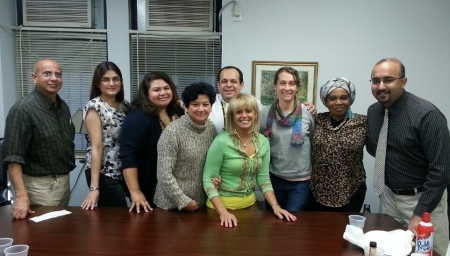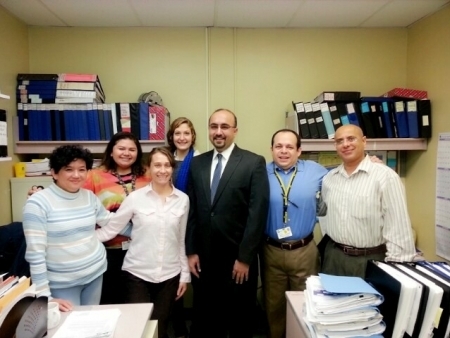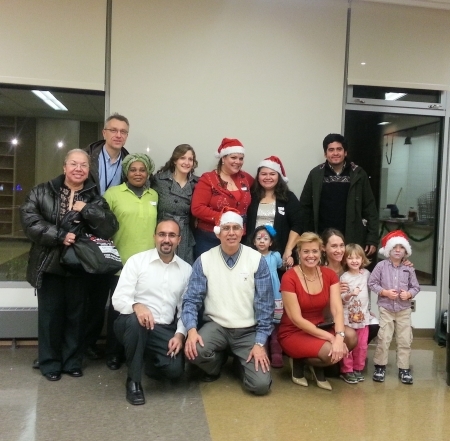Bronx-Lebanon Hospital (Site 13)

Clinic Location
Our site is located in the South and Central Bronx, New York. Many people do not know that the Bronx is home to Yankee Stadium. Our hospital is located just a few subway stops away in a diverse and vibrant neighborhood. A large portion of the community comprises immigrants from West Africa and South/Central America and the Islands.
Our Staff
Emma Stuard, MD oversees SMARTT activities. She has worked with PHACS since it was started, and is the oldest serving member of the Division of Pediatric Infectious Disease since 1999.
Mirza Mahboobullah Baig, MD oversees AMP activities. He has worked with PHACS since it started as well, having joined the Division in 2004.
Marvin Alvarado, MD works with Emma mainly on the Static Cohort of SMARTT. He has been with the Division since 2008.
Rita Sondengam, MPH is the overall PHACS study coordinator and is the most recent addition to the PHACS team at Bronx-Lebanon, commencing in February of 2014, replacing Mary Elizabeth Vachon, who in turn had worked with PHACS since 2008.
Levi Cherian, MS, is a data entry research assistant. He joined the Division in 2013.
Dr. Murli Purswani serves as the PI and provides not only the medical care, but has arranged through service grants to provide nutritional and social support to the families here. He has been with the Bronx-Lebanon Hospital since 2000.
Our CAB
Our CAB is called the PCAB (Pediatric Community Advisory Board). It was founded in September, 2008, and comprises nine CAB members that reflect the profile of this PHACS and IMPAACT site. They are parents of children who are either infected or exposed but uninfected who are receiving their care at Bronx-Lebanon Hospital Center. The CAB acts as a “bridge between the hospital and the community by providing information, encouraging participating and facilitating equal access to services and clinical trials”. This is an active and dynamic CAB that has responded well to its mission and regularly sends members to the PHACS meetings.
What is one word that describes your CAB?
Our CAB is engaging.
Tell us about your CAB. What makes it great? What are some of your most recent activities?
The Pediatric Community Advisory Board (CAB) is composed of a steady, dynamic group of 9 members who meet once a month. The CAB is very active and participates in an array of activities, including protocol and informed consent review, research discussions and trainings, and community and network events. The CAB members are very enthusiastic and are always interested in learning about new research and issues of community importance. At our last meeting, the CAB participated in a training about the PHACS Pulmonary Complications substudy. Mirza, our site’s PHACS Research Associate, explained the substudy and answered questions about it. Over the past couple of months, the CAB held a discussion about the Mississippi ‘Cure’ Baby, participated in a PHACS conference call about the dissemination of research results, attended a talk on HIV criminalization, and held a protocol review training.
What makes you feel like a group?
Our CAB is a very tight-knit group of community members. The CAB feels like a group because we have 9 consistent members who attend almost every meeting. This is helped by the fact that our CAB contract specifies that in order to be considered a CAB member; the member cannot miss more than 3 meetings in a row. In addition, members tend to keep each other accountable for attendance, which helps to foster relationships between CAB members.
Are there any resources you use that you’d like other sites to know about?
We oftentimes use parts of IMPAACT community resources and CAB trainings that are available on the IMPAACT/PHACS website to design our trainings.
What are some words you would use to describe your staff?
We are hard working, wonderful, patient, team players, and excellent.
What tip can your site share on how to make a study visit run smoothly?
The staff establishes rapport with the study participants, and educates the study participants on the visit procedures and how long the visit will last, so that they know what to expect.
Please give specific examples of how your research team tries to make study visits comfortable for families.
The research site has a comfortable waiting area that has a TV, games and videos for children. The site also provides food vouchers and cab/taxi fares to study participants.
Please share a valuable contribution one of your participants has made to improve your site.
A study participant while watching TV heard of a side effect of the medication she was taking that was not mentioned in the protocol and informed the site. The protocol was subsequently amended to include the side effect.
Will your office be doing anything special in the coming months (March – September 2014)?
We have impromptu lunches for the staff, and also in Fall carry out a Bake Sale on the hospital’s premises to ensure that all our patients have a Christmas Party and Presents.




